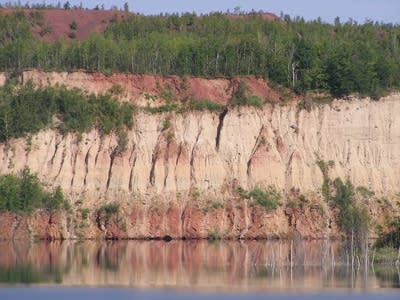Agencies debate while mine pit fills

From Bovey, The Canisteo Pit just looks like a steep hill, rising well above the homes and trees on the west side of town. Nestled among the old houses is Enstrom Photography studio.
"Yeah, it's, it's in our backyard, basically," said Tim Henning, with Enstrom's studio.
The old Canisteo mine pit is just down the block. Beyond the high berm wall are about two square miles of water some 300 feet deep. There's so much water that it saturates the surrounding ground below the surface and leaves residents more than a little uneasy.

Henning said the sump pump in the studio's basement runs every day, all year around.
Create a More Connected Minnesota
MPR News is your trusted resource for the news you need. With your support, MPR News brings accessible, courageous journalism and authentic conversation to everyone - free of paywalls and barriers. Your gift makes a difference.
"Actually when we lost our pump one week, we ended up with about three and a half feet of water in the basement," Henning said. "You know, the pressure of the water (can) eventually erode the foundation, possibly damaging it or weakening it."
Ground water from springs has been filling the pit since the last mining company left in the mid-1980s. There's no outlet for the water. Some residents fear the it will eventually come right over the top of the pit wall, or worse, spill through in a sudden and unpredictable rupture.
Images of the New Orleans flood come to mind.

A plan was drawn up to bring down the water level, and last year the state approved $3.5 million to do that. But it hasn't started.
The Department of Natural Resources has to approve the plan and DNR officials don't like it.
DNR hydrologist John Adams said it would cost some agency -- probably his -- up to $100,000 a year forever. The problem is the plan calls for an elaborate system of siphons.
"It's a long-term operation and maintenance problem" Adams said, in the DNR office in Grand Rapids. "And it puts us in the middle of having to do a lot of intensive monitoring and watch a system very carefully. We just don't think that's necessary."

Not necessary, Adams said. Engineers who studied the pit for the first time last summer found no flood danger.
"Their conclusion was that the pit wall is relatively stable; that there was very little chance that it would breech and flood parts of Bovey," said Adams. "They concluded that one of the most important things that could be done would be to stabilize the water level."
DNR officials think that just keeping the water level stable will protect the pit wall. So, the DNR drew up a second plan, to keep the water about where it is. Additional water would be drawn off and routed through a series of wetlands to a river to the west.
Adams said the only real problem is the water now seeping into basements, so the DNR proposes a tile system in Bovey to drain excess groundwater.
Meanwhile, another agency, the Western Mesabi Mine Planning Board, has drawn up a third plan, to temporarily pump water out the eastern end of the pit, and eventually let it flow out that end naturally.
So there are two agencies and three solutions and the water's still rising.
No wonder Bovey Mayor Deborah Trboyevich is frustrated.
"We're very unhappy about the delay," Trboyevich said. "Basically the last few years, in fact probably four or five years ago, we started noticing a lot of groundwater infiltration into our waste water system. And then we had complaints from some of the residents in town. Their basements were getting wet."
Studies last summer confirmed the pit was to blame for much of the extra water.
Trboyevich wants a solution and quickly. She doesn't trust the DNR's plan, which wouldn't actually lower the water in the pit.
And, she said, despite the DNR's reassurances, residents are worried the pit could burst someday, making a real mess of the region.
"Mother Nature's going to do what Mother Nature's going to do," Trboyevich said. "It's saturated. So, who knows what could happen? You know, they can't guarantee one way or the other."
The DNR's John Adams wants to get to work on something this summer. There's a danger that unspent money isn't going to sit on the shelf for long -- not in this tight economy.
The leading agencies, including the DNR and Western Mesabi Mine Planning Board are now expected to get together in Bovey next week to hash out the competing plans. Locals are hoping that something gets started soon, before the Canisteo pit makes its own choice.
